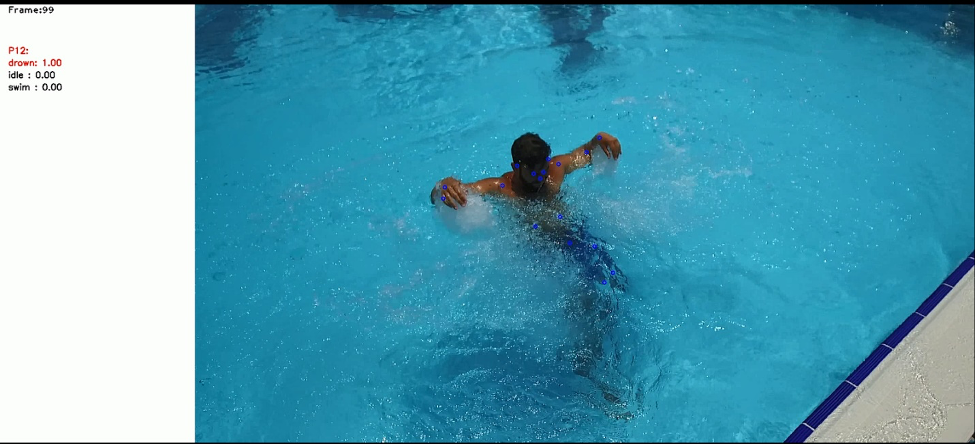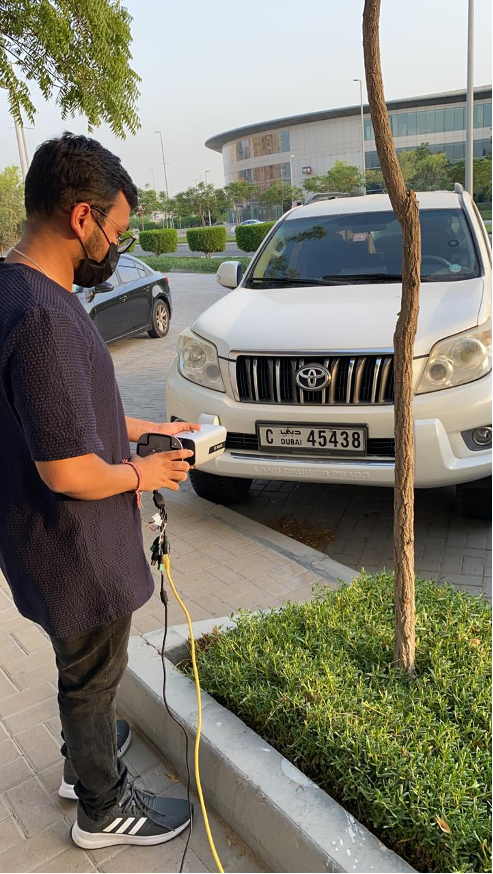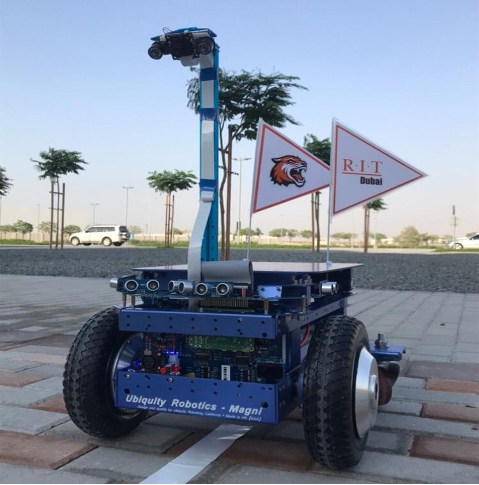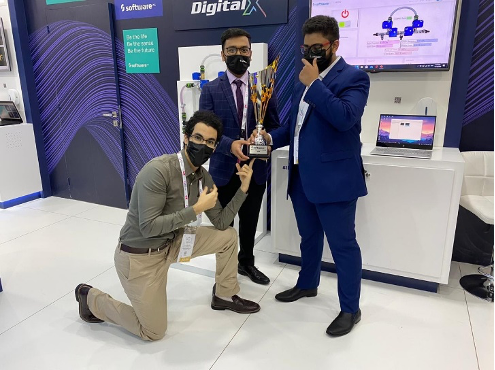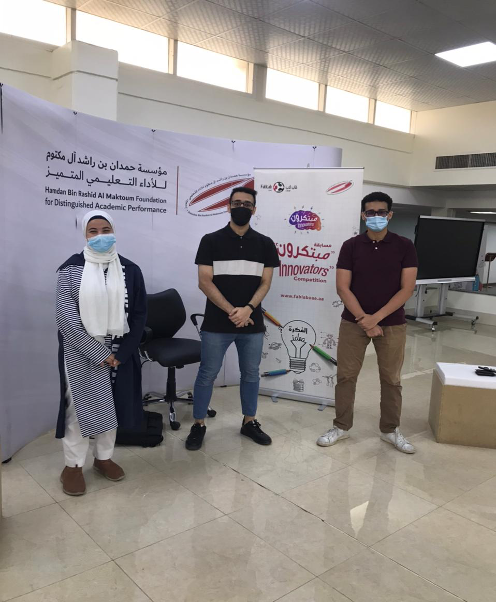AI/Robotics Lab
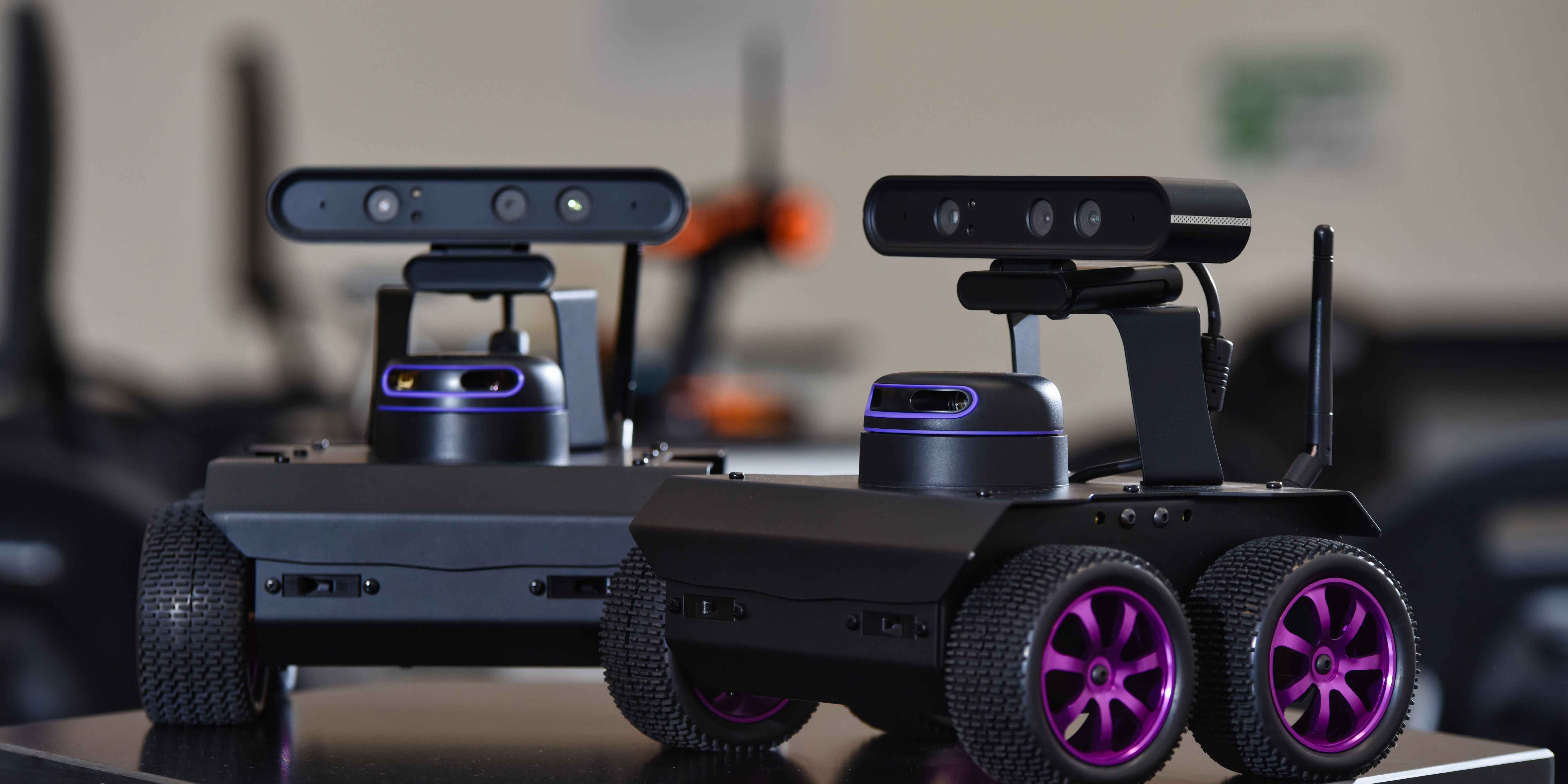
AI/Robotics Lab
The AI/Robotics lab fosters different use cases and projects in both AI (machine learning and deep learning) and Robotics with state-of-the-art equipment to support applications related to path planning, navigation, SLAM, Pick, and Place. Moreover, the AI/Robotics lab incorporates the AI/Robotics student club whose mission is to support students with extracurricular activities that provide them with better exposure and learning experience of skills related to AI and robotics.
The AI/Robotics lab supports regular lab experiments, mini-projects, independent studies, design/capstone, and thesis-based projects. The key undergraduate courses that make use of this lab are EEEE-585, EEEE-547, EEEE-497/498 (Capstone). The AI/ Robotics Laboratory consists of 4 ROSbot 2.0 Pro, 2 PhantomX AX Metal Hexapod MK-III, 1 Ubiquity Magni-Silver, 4 WidowX 250 Robot Arm, 2 Bioloid GP Humanoid Robots, 5 Dell OptiPlex 7470 AIO 24”, an instructor PC Dell OptiPlex 7070 SFF 22” LCD and a smart panel 86” Touch Panel from ViewSonic.
The ROSbot is an autonomous mobile robot platform that is powered by ROS (robot operating system). It also serves as a base for the further development of other robotic applications, and it is available in two versions: 2.0 and 2.0 PRO. Both versions encompass 4 wheels that contain DC motors, an Orbbec Astra RGBD camera, an MPU 9250 inertial sensor, and a rear panel. As per the picture demonstrated, the ROSbot 2.0 PRO is also equipped with a CORE2-ROS controller and an RPLIDAR A3 laser scanner.

The PhantomX AX Metal Hexapod MK-III is built using aluminum servo frames, leg components, a body set, and an expansion deck that allows users to add further components such as sensors or actuators. It also includes advanced inverse kinematics and an open-source Arbotix-M microcontroller that deems the robot to be extremely flexible. The robot can be then controlled by using a wireless Xbee control.

The WidowX 250 Robot Arm, designed by Interbotix, provides 5 degrees of freedom with an addition of a full 360 degrees rotation. It is mounted on a high-grade industrial bearing base and is constructed using extruded aluminum. The gripper can also be interchangeable and customized by 3D printing according to the user’s preferences. The robot arm can reach any object up to 65 cm within its reach with a total span of 1.3 m.

The Bioloid GP Humanoid is composed of aluminum frames, Dynamixel motors, various sensors, and a controller. It is popular in many robot competitions, and it is run by using RoboPlus, which is a powerful GUI-based programming software. It can be then controlled using a wireless remote controller. Also, its high functionality allows it to complete many tasks, and interesting features such as basic humanoid battle and soccer motions are provided.

The Magni Silver Mobile Base provides an affordable robot platform that can be used to kickstart the development of further robotic applications. It is powered by ROS, which allows it to handle communication, localization, and mobility. The Magni is also equipped with powerful motors and chassis for better navigation. In addition, it comes with power sufficient for external hardware.

Faculty
Assistant Professor of Electrical Engineering
Ph.D. in Electrical Engineering from Arizona State University, USA
Field of Expertise: signal and image processing, machine learning, computer vision, visual quality analysis, biomedical imaging.
Assistant Professor of Mathematics and Electrical Engineering
Ph.D. in Systems and Control Engineering; City, University of London
Field of Expertise: control system analysis and design including modeling and optimization techniques in both linear and nonlinear cases.
Students
-
Saifeldin Hasan, President
-
Rawan Elkaial, Vice President
-
Manan Agarwal
-
Huzaifa Khambaty
-
Atiqa Mohsin Ali Khan
-
Syed Haris Roman Hussaini
-
Abdelrahman El Sabaawi
-
Sabrina Al Bukhari
-
Amr Mohamed

Smart Pipeline (Independent Study Project)
Mentors: Dr. Jinane Mounsef, Dr. Ali Raza
Students: Saifeldin Hasan, Manan Agarwal, Huzaifa Khambaty, Maryam Najjar, Ayesha Raza, Kajol Jethani
Stakeholder: Software AG
The project, under the category of 'smart city use-cases, presents an innovative approach for monitoring leakage in water pipes and provides corrective actions. Powered by the Software AG Cumulocity platform, the prototype used water flow sensors, microcontrollers, and valves to create a system that allows the user to interact with, monitor the state of the pipeline, and collect information from a remote location. Using an IoT system and a Cloud server, remote detection and monitoring allow more efficient detection of the leaks while being environmentally friendly and cost-effective. The Smart Pipeline Leakage Control is a solution that can be implemented as part of a smart city. It aims to save resources that are otherwise wasted during transportation in pipelines, such as freshwater, oil, and gas in large pipelines. The system aims to be non-intrusive and easily applicable to already existing pipelines to provide real-time monitoring, fast detection of leaks, and an alternative path to bypass leakages until the issue is resolved.
Drowning Detection Software (Co-op Research Project)
Mentor: Dr. Jinane Mounsef
Students: Saifeldin Hasan, John Joy, Manan Agarwal, Huzaifa Khambaty, Fardin Ahsan
Stakeholder: DSO
The project consists of building a water behavior dataset and develop anti-drowning software to efficiently detect any drowning incident captured by cameras in the pool. The research project required to publish the results of detecting and recognizing water activities behaviors by using the capabilities of computer vision and deep learning.
Smart Gate (Independent Project)
Mentors: Dr. Muhieddin Amer, Dr. Jinane Mounsef
Students: Manan Agarwal, Huzaifa Khambaty
Stakeholder: TDRA
The software uses a YOLO model trained using the Darknet which is used to detect the license plate from the image or live video. We have received 100% accuracy in detecting the number plate. After detecting the number plate, the license plate is cropped and sent for character segmentation. Then Tesseract-OCR is used to run character recognition. The recognized characters are sent for validation after which if validated, the output is given.
Tiger BOT (Capstone)
Mentors: Dr. Muhieddin Amer, Dr. Jinane Mounsef
Students: Sara Badri, Dawoud Shakhsheer, Abdelrahman Abbas
TDRA: RTA
Autonomous vehicles play a crucial role in optimizing the traditional transportation process in terms of reducing time and cost, increasing safety, and being environmentally friendly. Naturally, the need arises to extend the benefits of autonomous vehicles to more specific applications, such as logistics and goods handling. This project proposes the use of a ground-based self-driving vehicle for use in the field of logistics while considering cost and efficiency as the main criteria. Our proposed solution, the Autonomous Tiger Bot (Auto T-Bot), utilizes an uncostly fusion of camera and ultrasound sensors to complement each other in providing the most comprehensive view of the environment through the data they provide to the autonomous vehicle. Equipped with a Raspberry Pi, a ROS middleware at its foundation, a stereo camera, and five ultrasonic sensors, our autonomous vehicle uses an ensemble of state-of-the-art methods for path planning, navigation, object detection, and avoidance. By utilizing the strong, yet cost-effective robot base Magni Silver, our robot should be capable of efficiently delivering a parcel to its destination. Moreover, our solution considers preserving the parcel in its initial state, regardless of the weather conditions. This is accomplished through the addition of temperature-control measures. Finally, an unlock-by-pin security feature is provided so that no external tampering can affect the parcel whilst in route.
Mosa’ed (Capstone)
Mentors: Dr. Jinane Mounsef, Dr. Ali Raza
Students: Amr Mohamed, Sherif Reda Hassan, Mohammed Adham, Habiba Al Shahhat, Arjun Nair
Stakeholder: Rashid Hospital
This project aims to develop an approach to support medical practitioners by ensuring that the diagnosis is not impeded based on the misinterpretation of patient responses. The initial approach reported in this work adopts the methods used by practitioners in the diagnosis carried out within the scope of the Emirati and Egyptian Arabic dialects. In this project, we develop and provide a public dataset, known as the Arabic Dialectal Diagnostic (ADD) dataset, which is a corpus of audio samples related to healthcare. In order to train machine learning models, the dataset development is designed with multi-class labeling. Models trained with this dataset are used to support the diagnosis made by medical practitioners.
Covid Band (Capstone)
Mentors: Dr. Jinane Mounsef, Dr. Boutheina Tlili
Students: Syed Haris Roman Hussaini, Abdulwahed Sultan, Khaled Duweik, Akrom Mamasaliev, Amir Risan, Abdullah Feknous
This project designs the COVID-Band, which uses IoT technology to monitor the safe distance, body temperature, and pulse rate of school students. The proposed work provides an efficient digital tool to help accelerate detection, reporting, active surveillance, and rapid response for COVID-19 cases at schools.
Gitex 2020 Future Disruptors Award
Smart Pipeline project won first place in Gitex 2020 and received the Future Disruptor’s award with the American University in Dubai and the University of Wollongong as runners-up.
American University of Emirates Student Research Competition (AUESRC)
The AUESRC is a research competition open for both undergraduate and graduate students in the GCC to share their findings. This competition is intended for students who have developed a creative project. The eligible projects can be capstone projects, thesis and dissertation, directed research, and fellowship research. The Covid-Band project won first place in the 2021 AUESRC, held on April 11-12,2021, competing against more than 50 local and international universities.
IEEE SIGHT JEH21 Hackathon
In this hackathon, the competitors need to develop a technological idea to solve the humanitarian problems caused by COVID-19 in education, healthcare, finance, social, and other pandemic-related problems. The Covid Band project won first place with the University of Spain and Coventry University at TKH from Egypt as runners-up.
Dubai World Self-Driving Challenge (RTA)
The Dubai World Self-Driving Challenge is an international competition hosted by the Dubai Roads and Transport Authority (RTA), that aims to tackle the major transport challenges by bringing together industry leaders, start-ups, and academia. The competition focuses on finding innovative solutions to advance self-driving technology. The Tiger Bot project was selected as one of 6 finalists from different UAE universities.
FabLab Competition
The objective of the competition is to attract creative individuals and teams who have innovative ideas. The competition provides the appropriate environment where creative and innovative people can turn their ideas into reality through Fablab UAE. The participants must pass the first and the second assessment stages to win this competition. At the first stage, the teams should submit the implementation plan of their respective Innovative project, which will be reviewed and assessed by a specialized jury. If qualified, the selected innovative projects will pass the first stage into the implementation stage. Mosa’ed project was qualified for the implementation phase with 5 other teams from UAE universities.
Extramural Activities: The students' members have reached out to high school students by giving them presentations about the AI/Robotics lab and offering them a tour of the lab.
Workshops: The students' members organized workshops in Arduino and Python with the collaboration of Fun Robotics.
Undergraduate Students
-
John Joy, Jinane Mounsef, “Automated Material Take-off using Computing Vision”, 2021 IEEE International Conference on Industry 4.0, Artificial Intelligence, and Communications Technology (IAICT), Indonesia, July 2021.
-
Rasem Alashkar, Mohamed ElSabbahy, Ahmad Sabha, Momen Abdelghany, Boutheina Tlili, Jinane Mounsef, “AI-Vision Towards an Improved Social Inclusion”, IEEE/IUT International Conference on Artificial Intelligence for Good (AI4G), Geneva, Switzerland, September 2020.
-
Saifeldin Hassan, John Joy, Huzaifa Khambaty, Manan Agarwal, Fardin Ahsan, Jinane Mounsef, "A Water Behavior Dataset for an Image-Based Drowning Solution", submitted to the IEEE Green Energy and Smart Systems Conference, November 2021.
Graduate Students
-
Jinane Mounsef, Boutheina Tlili, Anum Faraz, "Extended AI Vision for an Enhanced Social Inclusion", submitted to the Special Issue on Innovation in Computing, Engineering Science & Technology organized by Advances in Science, Technology and Engineering Systems Journal (ASTESJ), July 2021.
-
Yazan Al Najjar, Jinane Mounsef, “Next-Generation Network Intrusion Detection System (NG_NIDS)”, 2021 IEEE 19th International Conference on Smart Technologies (EUROCON), Lviv, Ukraine, July 2021.
-
Soliman Awad, Jinane Mounsef, "Facial Recognition under Adversarial Attack", a manuscript under preparation.

